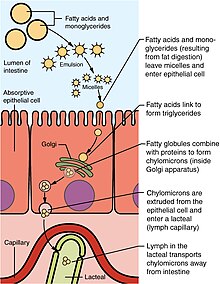Lipid metabolism
Lipid metabolism is the synthesis and degradation of
Metabolic processes include lipid digestion, lipid absorption, lipid transportation, lipid storage, lipid catabolism, and lipid biosynthesis. Lipid catabolism is accomplished by a process known as
Lipid digestion
Digestion is the first step to lipid metabolism, and it is the process of breaking the triglycerides down into smaller monoglyceride units with the help of lipase enzymes. Digestion of fats begin in the mouth through chemical digestion by lingual lipase. Ingested cholesterol is not broken down by the lipases and stays intact until it enters the epithelium cells of the small intestine. Lipids then continue to the stomach where chemical digestion continues by gastric lipase and mechanical digestion begins (peristalsis). The majority of lipid digestion and absorption, however, occurs once the fats reach the small intestines. Chemicals from the pancreas (pancreatic lipase family and bile salt-dependent lipase) are secreted into the small intestines to help breakdown the triglycerides,[10] along with further mechanical digestion, until they are individual fatty acid units able to be absorbed into the small intestine's epithelial cells.[11] It is the pancreatic lipase that is responsible for signalling for the hydrolysis of the triglycerides into separate free fatty acids and glycerol units.
Lipid absorption

The second step in lipid metabolism is absorption of fats. Short chain fatty acids can be absorbed in the
Lipid transportation
Due to the hydrophobic nature of
Lipid storage
Lipids are stored in white adipose tissue as triglycerides. In a lean young adult human, the mass of triglycerides stored represents about 10–20 kilograms. Triglycerides are formed from a backbone of glycerol with three fatty acids. Free fatty acids are activated into acyl-CoA and esterified to finally reach the triglyceride droplet. Lipoprotein lipase has an important role.[13]
Lipid catabolism
Once the chylomicrons (or other lipoproteins) travel through the tissues, these particles will be broken down by
![[15] Breakdown of fatty acids by beta oxidation](http://upload.wikimedia.org/wikipedia/commons/thumb/c/cb/Beta_oxidation_of_palmitic_acid.jpg/705px-Beta_oxidation_of_palmitic_acid.jpg)
In the cytosol of the cell (for example a muscle cell), the
- 7 FAD + 7 NAD+ + 7 CoASH + 7 H2O + H(CH2CH2)7CH2CO-SCoA → 8 CH3CO-SCoA + 7 FADH2 + 7 NADH + 7 H+
Lipid biosynthesis
In addition to dietary fats, storage lipids stored in the adipose tissues are one of the main sources of energy for living organisms.[17] Triacylglycerols, lipid membrane and cholesterol can be synthesized by the organisms through various pathways.
Membrane lipid biosynthesis
There are two major classes of membrane lipids: glycerophospholipids and sphingolipids. Although many different membrane lipids are synthesized in our body, pathways share the same pattern. The first step is synthesizing the backbone (sphingosine or glycerol), the second step is the addition of fatty acids to the backbone to make phosphatidic acid. Phosphatidic acid is further modified with the attachment of different hydrophilic head groups to the backbone. Membrane lipid biosynthesis occurs in the endoplasmic reticulum membrane.[18]
Triglyceride biosynthesis
The phosphatidic acid is also a precursor for triglyceride biosynthesis. Phosphatidic acid phosphotase catalyzes the conversion of phosphatidic acid to diacylglyceride, which will be converted to triglycerides by acyltransferase. Triglyceride biosynthesis occurs in the cytosol.[19]
Fatty acid biosynthesis
The precursor for fatty acids is
8 Acetyl-coA + 7 ATP + 14 NADPH + 6H+ → palmitate + 14 NADP+ + 6H2O + 7ADP + 7P¡
Cholesterol biosynthesis
Lipid metabolism disorders
Lipid metabolism disorders (including
Types of lipids
The types of lipids involved in lipid metabolism include:
- Membrane lipids:
- Phospholipids: Phospholipids are a major component of the lipid bilayer of the cell membrane and are found in many parts of the body.[23]
- Sphingolipids: Sphingolipids are mostly found in the cell membrane of neural tissue.[18]
- Glycolipids: The main role of glycolipids is to maintain lipid bilayer stability and facilitate cell recognition.[23]
- Glycerophospholipids: Neural tissue (including the brain) contains high amounts of glycerophospholipids.[23]
- Other types of lipids:
- Cholesterols: Cholesterols are the main precursors for different hormones in our body such as progesterone and testosterone. The main function of cholesterol is controlling the cell membrane fluidity.[24]
- steroidogenesis: Steroids are one of the important cell signaling molecules.[24]
- Triacylglycerols (fats) – see also lipolysis and lipogenesis: Triacylglycerols are the major form of energy storage in human body.[1]
- Fatty acids – see also fatty acid metabolism: Fatty acids are one of the precursors used for lipid membrane and cholesterol biosynthesis. They are also used for energy.
- Bile salts: Bile salts are secreted from liver and they facilitate lipid digestion in the small intestine.[25]
- Eicosanoids: Eicosanoids are made from fatty acids in the body and they are used for cell signaling.[26]
- Ketone bodies: Ketone bodies are made from fatty acids in the liver. Their function is to produce energy during periods of starvation or low food intake.[6]
References
- ^ a b c d e "Overview of Lipid Metabolism". Merck Manuals Professional Edition. Retrieved 2016-11-01.
- ^ a b c "Hydrolysis – Chemistry Encyclopedia – structure, reaction, water, proteins, examples, salt, molecule". chemistryexplained.com. Retrieved 2016-11-01.
- ^ ISBN 978-0-86720-069-0.
- ISBN 978-1-4557-4580-7.
- PMID 19725772.
- ^ ISBN 978-1-57259-931-4.
- ^ Ophardt CE (2013). "Lipid Metabolism Summary". Virtual Chembook. Elmhurst College.
- JSTOR 2430826?.
- ^ PMID 27293434.
- ISBN 978-0-323-07446-9.
- OCLC 738349533.
- ISBN 978-90-481-8621-1.
- ^ Mechanism of Storage and Synthesis of Fatty Acids and Triglycerides in White Adipocytes | Physiology and Physiopathology of Adipose Tissue pp 101–121 | DOI: 10.1007/978-2-8178-0343-2_8
- PMID 26247089.
- ^ a b c "Fatty Acid beta-Oxidation – AOCS Lipid Library". lipidlibrary.aocs.org. Archived from the original on 2019-01-21. Retrieved 2017-11-28.
- ^ ISBN 978-0-470-04073-7.
- PMID 27148161.
- ^ PMID 20919643.
- ^ PMID 1269065.
- ^ a b "Lipid Metabolism Disorders". MedlinePlus. Retrieved 2016-11-20.
- ISBN 978-0-443-02297-5.
- ^ a b "Disorders of Lipid Metabolism". Merck Manuals Consumer Version. Retrieved 2016-11-20.
- ^ ISBN 978-0-8153-3218-3.
- ^ PMID 10712926.
- PMID 12543708.
- S2CID 34803631.
Lipid+metabolism at the U.S. National Library of Medicine Medical Subject Headings (MeSH)

